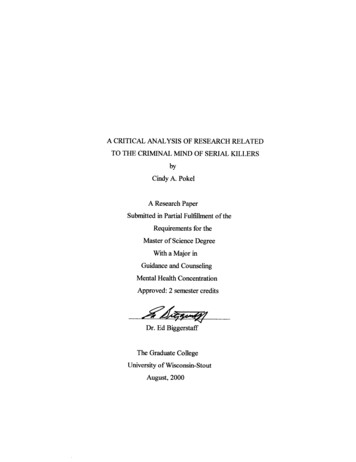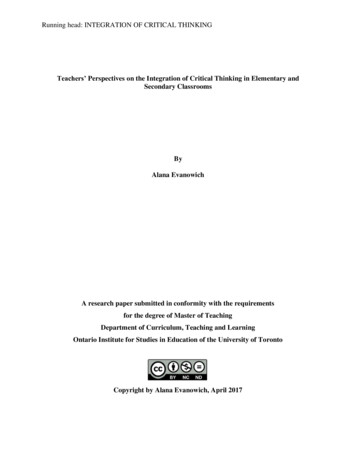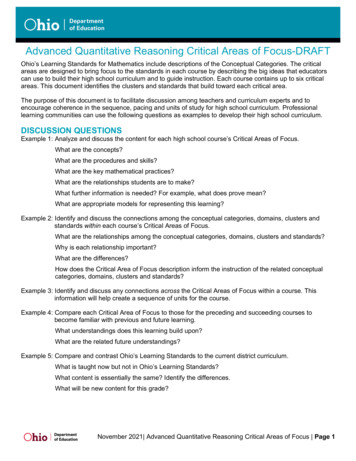
Transcription
A CRITICAL ANALYSIS OF RESEARCH RELATEDTO THE CRIMINAL MIND OF SERIAL KILLERSbyCindy A. PokelA Research PaperSubmitted in Partial Fulfillment of theRequirements for theMaster of Science DegreeWith a Major inGuidance and CounselingMental Health ConcentrationApproved: 2 semester creditsDr. Ed BiggerstaffThe Graduate CollegeUniversity of Wisconsin-StoutAugust, 2000
ABSTRACT(Writer)Pokel(Last Name)Cindy(First)A(Initial)A Critical Analysis of Research Related to the Criminal Mind of Serial Killers(Title)Guidance and Counseling(Graduate Major)Dr. Ed Biggerstaff8/200061(Research Advisor) (Month/Year) (No. of Pages)American Psychological Association (APA)(Name of Style Manual Used in this Study) Serial murder is the most commonform of multiple murder. Serial murder is characterized by the killing of three ormore persons over a period of days, weeks or years with a cooling off periodbetween murders (O'Reilly-Fleming, 1996, p. 17). Research has shown an increasein the amount of serial murders that has occurred in the second half of thetwentieth century with a trend that is destined to continue. Federal Bureau ofInvestigation statistics report that there are 20,000 murders per year and over thepast 20 years murder and manslaughter has increased 300%. The field ofpsychology and law continues to search for a pattern of behavior that can help themental health field in identifying characteristics of serial killers through interviewsand evaluations. The purpose of this study was to examine research related to this
problem of developing prospective characteristics of serial killers and to share thefindings with professionals in the field of forensic psychology. The researchobjectives of this study were to examine the history of serial killing in bothWisconsin and the United States, to compare the past trends to the present trends,and to identify and critically analyze the different characteristics identified inresearch related to topic of serial killers.
AcknowledgementI would like to acknowledge those individuals who were a part of thisjourney. Dr Ed Biggerstaff, my thesis advisor and friend, who provided me withguidance and support. A very special thank you to my partner Karen whoremained my inspiration to complete this project.In loving memory of my father, Carlton Pokel, who is always present ineverything I do as my guardian angel. I also acknowledge my mother and brotherfor their love and support.Finally, a special thank you to my fellow team members at the Eau ClaireCounty Community Support Program who remained understanding, supportiveand patient and gave me extra push when I needed it to complete this projectbefore the next millennium.i
TABLE OF CONTENTSPageACKNOWLEDGEMENTTABLE OF CONTENTSiiCHAPTER ONEINTRODUCTION1STATEMENT OF THE PROBLEM3PURPOSE OF THE STUDY3RESEARCH OBJECTIVES3DEFINITION OF TERMS4CHAPTER TWOREVIEW OF LITERATURE5CHAPTER ENCES58ii
CHAPTER 1IntroductionThe crime of murder has been known to be present in our society since theearly 1600's. Historians who have done extensive research on the topic of murderhave found evidence of murder occurring in Ancient Rome and moving on throughthe centuries. One of the first known examples in modem times of, what wouldlater be termed a "serial killer", was Jack the Ripper, who killed and mutilated fiveprostitutes in the East End of London in 1888 (Wilson, 1990). The term "serialkiller" came into general use in American society in the 1980's as law enforcementofficials began to classify different types of murders.Serial killing today seems to be something that we only see or hear about inthe movie theater or in some true crime book. Serial killing is something of thepast that happens in far away places like Jack the Ripper in London, England. Asan American society we lull ourselves into a sense of false security believing thatserial murder is very rare and easily detected by law enforcement officials.Crime statistics and experts in the field of serial murder predict that 35 to50 serial killers may be active across the United States at any given time because1
"multiple homicides frequently occur in a manner that doesn't clearly indicate theyare part of a pattern" (APB News Online, 2000).As we look closer to home inWisconsin, the Crime Rates from 1960-1997 paint a very horrifying picture, as thenumber of murders in 1997 was 205. This is a 410% increase over the 50 murdersthat occurred in 1960 (The Disaster Center, 1999). The State of Wisconsin hasbeen 35 years old, who can have a high or low income. Average to highintelligence and usually married with children and have a career (Ressler, et al,1988,pg.29). This suddenly describes a very large percentage of people in oursociety. It's not so easy to identify a serial killer and we as a society have beenlead to believe otherwise by the media.The profile above is relatively broad and doesn't begin to examine whatmotivates an individual to commit a series of murders. The research related toserial killing has attempted to classify the motives of an individual that commit aseries of murders. Dr Ronald Holmes in his book " The World of Serial Killers"has identified four types of serial killers. The first type is identified as a "visionaryserial killer". The visionary serial killer is commanded to kill by voices or visions.The second type of serial killer is identified as the "mission serial killer". Themission serial killer is interested in ridding the community from undesirableindividuals. The third type of serial killer is a "hedonistic serial killer". Lust, thrill2
and comfort drive the hedonistic serial killer. The last type of serial killer is the"power/control serial killer". The power/control serial killer is motivated by theneed for power and dominance (Holmes, 2000).Statement of the ProblemResearch has shown an increase in the amount of murders that haveoccurred in the second half of the twentieth century with a trend that is destined tocontinue. The field of psychology and law continues to search for a pattern ofbehavior that can help the mental health field in identifying characteristics of serialmurderers through interviews and evaluation.Purpose of the StudyThe purpose of the study will be to provide a review and critical analysis ofthe research and literature related to the known patterns of behavior of serialmurderers and to examine aspects of the criminal mind related to serial murderersand share the findings with professionals in the field of forensic psychology.Research Objectives1. To examine research related to the history of serial murder in Wisconsin and theUnited States.3
2. To compare the past trends of serial murder to the present trends of serialmurder.3. To review research related to the evaluation of the criminal mind of serialmurderers.4. To examine the different types of murder to include single victims versusmultiple victims committed by adult males and adult females.5. To identify patterns in behavioral characteristics of serial murderers to aide infurther future research on the topic.Definition of TermsA. Types of Murder1. Serial murder: a serial murder is defined as an event in which a person killstwo or more victims in incidents that are geographically unrelated.2. Mass murder: a mass murder is defined as an event in which a person killsfour or more victims at one time and place.3. Spree killer: a spree murder is a single event with two or more locations andno emotional cooling off period between murders.B. Cannibalism: the consumption of human flesh.C. Cult: a pejorative label used to describe certain religious groups.4
CHAPTER TWOReview of LiteratureMurder has been a dark presence in society since the beginning of time.Researchers have diligently studied murder to identify its causes. The centraltheme of studying murder is motivation. The question that is often asked is whatmotivates an individual to become a murderer. Theories include biologicalpredispositions, sociological influences and psychological factors.In order to begin this critical review and analysis of literature related to thecriminal mind of serial killers it is important to begin with an understanding of thedifferent types of murder and a brief historical overview of how we as a societyhave come to this point in studying the criminal mind of serial killers.There are a large variety of homicides and the legal system tends to putthem all together into one type. As Farmer and Hooker have noted, the legalsystem " artificially lumps together desperate activities under the single heading of"homicide" (Farmer and Hooker, 1987, p.3). This tends to disregard the fact thatdifferent types of homicides and motivations exist. Further research has helpedlaw enforcement to recognize the different types of homicide to include massmurder, spree killing, and serial killing. Mass murder is defined as a "single
eruption of violence that takes place in one location with a large number of randomvictims (at least four, according to an FBI criterion)" ( Schlecter and Everitt, 1997,p.179).A spree killing is defined as a killing in which "someone murders a string ofpeople in several different locations with no cooling off period between homicides"(Schlecter and Everitt, 1997, p.273).Finally, a serial killing has been defined by one author as a series of killingscommitted over a considerable span of time with the presence of a cooling offperiod (Schlecter and Everitt, 1997). In 1972, Cormier used the term "multicide"to define several homicides that had been committed by one person, but spreadover a period of time. The term multicide is closely synonymous with the term"serial murder". (Cormier, 1972). The German's described multiple murders in the1800's as "lustmord", or murder for pleasure. (Wilson, 1990). Egger's initialdefinition was developed in 1983, which was the first attempt to define serialmurder in a more comprehensive manner."Serial murder occurs when one or more individuals in most known cases,males, commit a second murder or subsequent murder; is relationship less (victimand attacker are strangers); occurs at a different time and has no connection to the6
initial (and subsequent) murder, and is frequently committed in differentgeographic locations. Further, the motive is generally not for material gain, but isusually a compulsive act specifically for gratification at of the murderer. A keyelement is that the series of murders do not share in the events surrounding oneanother. "Victims share common characteristics of what are perceived to beprestige less, powerless and/or lower socio-economic groups (that is vagrants,prostitutes, migrant workers, and homosexuals, missing children and single andelderly women)" (Egger, 1984, p.8-9).Ressler, Burgess, D' Agostino and Douglas also provided a very briefdefinition of serial murder in 1984. "Serial homicide involves the murder ofseparate victims with time breaks between victims, as minimal as two days toweeks or months. These time breaks are referred to as a "cooling off period"(Ressler et al, 1984, p.7).Levin and Fox (1985) in their book "Mass Murder" define serial murder asa type of mass murder (Levin & Fox, 1985). This definition addresses thepathology of the murderer's behavior:" This individual travels around, sometimes from state to state, searchingfor victims whom he can rape and sodimize, torture, dismember, stab andstrangle. Even these truly sadistic killers are, however, more evil than crazy. Few7
of them can be said to be driven by delusions or hallucinations, almost none ofthem talks to demons or hears strange voices in empty rooms. Though their crimesmay be sickening, they are not sick in either a medical or legal sense. Instead, theserial killer is typically a sociopathic personality who lacks internal control, guiltor conscience to guide his own behavior but has an excessive need to control anddominate others. He definitely knows right from wrong, definitely realizes he hascommitted a sinful act, but simply doesn't care about his human prey" (Levin andFox, 1985, p.229-230).Holmes and DeBurger (1988) in their book "Serial Murder" define serialmurder by its elements, which emphasize the traits of a serial murderer:·repetitive homicide, continuing if not prevented*primarily one on one*relationship less (victim-perpetrator) usually one of strangers or slightacquaintance*motivation is to kill, not conventional passion crime or victim precipitated*intrinsic motive (not apparent or clear cut) and ordinarily not for passion,personal gain or profit ( Holmes and DeBurger, 1988, p.18-19).For years the public has perceived murder as being motivated by two basicfactors to include the outcome of an altercation, a quarrel, a fit or rage, a reaction8
to an insult, jealousy and the like or for gain to include monetary, self protection orpower (Holmes and DeBurger, 1988). For "the serial killer, the motivation is notone of only money or power. The serial killer is simply motivated to kill, as you orI need water, the serial killer NEEDS to kill" (Serial Killers, Online, 2000).The prevalence of serial murder past, present and future can only beestimated. The literature provides no decisive answers to the question related toprevalence. The APB News Online quotes experts in advising that 35 to 50 serialkillers may be active across the United States at any given time. The absence of apattern makes it difficult to calculate multiple homicide frequencies.The homicide trends in the United States documented by the Bureau ofJustice statistics found that homicides are more likely to involve multiple offendersthan multiple victims. The percent of homicides involving multiple victimsincreased gradually during the last two decades from just under 3% of allhomicides to 4% (U.S. Department of Justice, 2000).The homicide trends in Wisconsin documented by the Disaster Centerreveal a startling increase in the amount of homicides over the past 37 years. In1960 Wisconsin reported only 50 murders. In 1997 Wisconsin reported 205murders. This is a 410% increase in less than four decades. As far as serialmurders are concerned, Wisconsin has been home to three known serial murderers9
to include two cannibals Edward Gein and Jeffrey Dahmer and Joseph Franklin.The remainder of this chapter will review a small sample of literaturerelated to serial murder to include academic textbooks, online articles, journalarticles and mainstream periodicals. The research related to the criminal mind ofserial killers has examined several different theories to explain the existence ofwhat some term "monsters" of our society. These theories can be divided intothree main categories to include biological, psychological and sociologicalexplanations. This chapter will examine several different prominent pieces ofliterature related to the criminal mind of serial killers.The first academic textbook by Steven Egger includes a chapter on asynthesis of literature and research related to serial murder. Within the chapter is asection related specifically to the patterns of serial killers. In 1977, Lundsgaardeexamined the pattern between the sentence and the relationship of the murderer tothe victim. Lundsgaarde found that those who killed a stranger received a harshersentence. The identity of the murderer's victim also helps to examine somecharacteristics of the murderer ( Lundsgaarde, 1977).De River in categorizing serial killers examines the Freudian aspect relatedto deviation or perversion of the sexual impulse (1949,p.99). These type of killersare generally "cold, calculating and egotistically sadistic" (DeRiver, 1949, p. 120).10
Dr. Helen Morrison, a practicing psychotherapist, who has interviewed anumber of serial murderers, tends to disagree with the theory related to a sexualtheme of serial murder. She states, "the incidence of sadomasochistic sex is veryhigh. The incidence of mass murder is not, at least in the sheer number ofperpetrators" (McCarthy, 1984, p.1).Levin and Fox (1985) found that a murderer is trying to feel superior overthe victim and triumph or conquer by destruction (Levin & Fix, 1985). Egger(1985) has noted that the motivational factor of a serial killer seems to beconsistent with research on the nature of rape (Egger, 1985). Leyton (1986)identifies deprivation as a provocation for the multiple murderers' frustration.Leyton has also argued that multiple murders are a "kind of sub-political andconservative protest, which nets the killer a substantial social profit of revenge,celebrity, identity and sexual relief' (Leyton, 1986, p.26).Wilson (1972) would agree with Leyton: "If man is deprived of meaningsbeyond his everyday routine, he becomes disgusted and bitter, and eventuallyviolent. A society that provides no outlet for man's idealist passions is asking tobe torn apart by violence" (p.233). Norris (1988), in his book "Serial Killers" listsa behavior pattern he labels "serial killer syndrome". The "serial killer syndrome"includes 21 patterns or symptoms of episodic aggressive behavior, which provide a11
profile or predisposition ( Norris, 1988).Levin and Fox (1985) found the terms "sociopath" and "psychopath" usedinterchangeably to describe serial murderers ( Levin & Fox, 1985). Dr HelenMorrison, who examined John Gacy for 800 hours feels the serial killer is a newpersonality type (Berger, 1984).Theories regarding inadequate socialization and childhood trauma are oftenfound in homicide literature as a possible causal factor of serial murder. Starr(1972) theorizes that human cruelty may be connected to the development of aserial murderer (Starr, 1972). Willie (1975) found the most common feature ofthe family background of serial murderers to be violent punishing practice inflictedupon the child ( Willie, 1975). Other literature has identified the existence of anunusual or unnatural relationship with the serial killer's mother (Lunde, 1996).Ressler (1984) found that a number of serial murderers had been fascinated withlaw enforcement.Research, to this point, has not been able to completely profile a serialkiller. Serial murder is predominantly a "stranger to stranger" crime and researchconducted is done from a case study approach. There has been little effort tocombine or collate research to examine patterns of a larger population of serialmurderers.12
Vetter has researched the correlation between dissociation, psychopathyand the serial murderer. It is often just assumed that someone who commits serialmurder must be "out of his or her mind". The current field of psychology does notoffer society a handy assessment tool that can easily identify a would be serialkiller. Part of the current problem is the near impossibility of conducting researchin which the judicial process takes precedence over any other consideration.Another equally important piece is the lack of a conceptual frame of reference toapproach convicted serial murderers in confinement (Vetter, 1991). Bernstein andPutnam (1986) have created an evaluation tool that can be used in the research ofdissociation and serial murderers. The Dissociative Experience Scale is a 28 itemself-report questionnaire that offers a means of reality measuring in normal andclinical populations (Bernstein& Putnam, 1986).In the book "Serial Murder" authors Holmes and DeBurger (1988)examine the types of serial murder in our modern society and take a closer look atbackground and behavior patterns. In classifying serial murder four basicquestions must be asked, which focuses upon looking at the behavioralbackground of the perpetrator, exploring the characteristics of the victims,examining the pattern of killing and method used and finally the location of theserial murders. The behavioral background examines three major root sources of13
criminal behavior to include biogenic, sociogenic and psychogenic. Motives canalso be extrinsic in that the motives to kill are located outside the individual psycheor intrinsic when the motives are in the psyche of the killer.In examining the victims the researcher is examining traits to includespecific and nonspecific traits. The selection of the victim is important to inexamining whether the killer made a random or nonrandom selection. Finally, therelationship pattern is important. It is important to determine whether the killerand victim were strangers or affiliates.Holmes and DeBurger (1988) identify four types of serial murder. Theyinclude the visionary type; the mission oriented type, the power/control type andthe hedonistic type. The visionary type includes those serial killers that respond to"voices" within. The mission oriented type serial killer has a goal of eliminating aparticular group or category of people. The power/control-oriented type seekssatisfaction from having complete life and death control over the victim. Finally,the hedonistic type is oriented toward pleasure or thrill seeking.Holmes and DeBurger (1988) examine the social cultural background ofknown serial murderers in the United States. There are two basic socioculturalsources that are important to the origins ofmulticidal behavior. One of theseincludes the persistent culture of violence in today's society that is occupied by14
continuous change in the nature of society-individual relations. The othersignificant factor is in the impact of violence in early development in a familysetting ( Holmes & De Burger, 1988).In the book "To Kill Again: The Motivation and Development of SerialMurder", author Donald Sears examines a "profile" of a serial murderer. Bycompiling and assessing the behavioral and developmental traits, a profile emergesof a "typical" serial murderer. Sears found that the early home life of serial killersis often one in which a stable nurturing atmosphere is absent. "Most serial killerstend to come from homes where they are physically or psychologically abused"(Sears, 1991, p.37).The Federal Bureau of Investigation in 1985 completed an exhaustive studythat found that most serial killers spent their childhood in unhealthy, uncaring andabusive homes (Federal Bureau of Investigations, 1985). The study also foundthat family histories of serial murderers highlighted multiple problems to includealcohol and drug abuse. The study found that most of the murderers evaluated hada weak attachment to their family members, and that there was present a parentwhom suffered from problems of substance abuse, criminality and aberrant sexualbehaviors. A common theme among all the murderers was a childhood with theabsence of the development of self worth. Fantasy was also a common theme15
among these murderers as often being isolated they turned to fantasy to escapetheir unpleasant environment (Federal Bureau of Investigations, 1984).Sears goes on to examine other personality traits that appear to be commonamong serial murderers. The absence of the presence of a loving and nurturingrelationship with parents creates great difficulties in developing and maintainingmeaningful relationships. The absence of meaningful relationships also impacts theaspect of sexual relationships. Often exposed to abuse and neglect as children,these murderers becomes fascinated with fantasy related to sex and violence. Anobsession with pornographic materials acts as an aid for a serial murderer toconstruct a sexual relationship on his mind.The serial murderer may appear to be very normal often pleasant andamiable. There is often the absence of any overt mental illness. Serial murderershave been found to be usually quite intelligent. Research has found the IQ level ofsuch serial murderers as Ted Bundy, JohnWayne Gacy and Wayne Williams rangedbetween 118 and 124.In both an academic and professional life, serial killers tend to be mostsuccessful and promising. Examples such as John Wayne Gacy and Ted Bundy areoften cited. John Wayne Gacy was a very successful businessman and Ted Bundywas an up and coming attorney.16
Sears concludes his brief overview of the profile of a serial killer by stating"the serial killer is obviously a distinctive and extremely dangerous criminal". Hepossesses a superficial charm, whereby he may effectively mimic appropriatesocially approved behavior in any given setting, but behind this carefullyconstructed facade he exhibits no genuine feelings and is insensitive to the welfareof others" (Sears, 1991, p.51).In examining the biological explanations of the serial murderer, Searspoints out that it is still a mystery of how human physiology, and more specificallythe brain, can be linked to aggression and violence. Research has identified fiveaspects related to biological functioning to explain the existence of serial killers.The five biological aspects include retardation in the development of the brain,head trauma, heredity and genetics, and increase in the male sex drive.The first biological aspect is the retardation in the development of thebrain. Researchers have examined electroencephalogram (EEG) readings ofmurderers' abnormality rates in individuals identified as psychopathic or psychotic.No specific research has ever been conducted on an identified group of knownserial murderers. It has been theorized that since some serial murderers sufferfrom some of the same characteristics of psychopaths and psychotics, retardationin the development of the brain could be a possibility.17
The second biological aspect considered by Sears is focusing the attentionon the thalamus, hypothalamus and their connection to aggression. If a serial killersuffers from an impaired thalamus it may cause a lack of empathy for the pain heinflicts on others as the thalamus is responsible for the relay center for processingsensory information. To this point no work has been done to examine thecorrelation between the thalamus and motivation to commit serial murders.The third biological aspect examined by Sears was the issue of headtrauma. According to Sears " as an explanation for serial murder, this theoryoffers at best a limited answer. Although it is true that many serial killers sufferedsome type of severe head injury during childhood, many others have no suchhistory" (Sears, 1991, p.1 12).The fourth biological aspect examined by Sears was the issue of heredityand genetics. Despite the series of genetic research, there has been no "crimegene" located. Many studies involving children who had been separated from theirbiological parents at birth examined the concept of inherited criminalcharacteristics. Researchers have found that what may be inherited aggression is ametabolic condition known as Lesch-Myhan disease. It may be possible that serialmurderers inherit a tendency for aggressive behaviors and turn to murder as a lastresort when other more appropriate outlets are not visible. The final biological18
aspect identified by Sears was the increase in the male sex drive. Levin and Foxhave theorized that the cause of serial murder is directly related to an increasingsex drive in men (Levin and Fox, 1985). According to Levin and Fox a "serialmurderer pursues this increased need for sexual stimulation to the point of murder"(Sears, 1991, p. 116). There appear to be a number of biological explanations, butwithout further research no one biological factor can be identified as "the" cause ofserial murder.In examining the psychological explanations of serial murder the mostpredominant theory is he suffers from an antisocial personality disorder.Individuals with antisocial personality disorder display the followingcharacteristics: superficial charm, intelligence, absence of delusions or irrationalthinking, lack of nervousness, unreliable, untruthful, and insincere, exhibits poorjudgment and fails to learn from experiences, pathogenic egocentricity andincapable of love. The antisocial personality disorder or psychopath is commonamong serial killers. A serial killer often engages in related criminal acts,experiences anxiety and tension, but experiences no guilt or remorse for hisactions.Sears theorizes that a serial killer's behavior "may be due to a deficientpsychological makeup that prevents normal emotional development" (Sears, 1991,19
p.59). Some researchers (Quay) postulates that a serial killer may be a hybridform of psychopath have theorized it. This certainly would explain the evengreater need for increased stimuli. A serial killers inability to feel emotion mayalso explain the serial killers need to kill again and again." Donald Lunde, in his book "Murder and Madness", proposes anothertheory, asserting . Those mass murderers, in general, are almost always insane"(Sears, 1991, p.62). Sears goes on to examine Lunde's beliefs that serial killers canbe classified into two types to include paranoid schizophrenics or sexual sadists.The paranoid schizophrenic experiences hallucinations, delusions, bizarre religiousideas, suspicion and aggression. Sears doesn't believe this classification fits thebehaviors of serial killers. Sears feel the second classification proposed by Lunderelated to sexual sadism is far more accurate.Another popular theory reviewed by Sears related to hatred. Sometheorists have proposed that serial killer harbors some deep hared toward allwomen due to underlying hate for some significant female in his life. Inpsychological terms this is often referred to as "displaced aggression". As we haveseen in cases such as Gacy, the hatred may also be towards young men and boys.This may play an important role in the motivation to kill.A final psychological explanation proposed by Sears suggested that serial20
killers' crimes come from some form of retarded or impaired emotionaldevelopment that may have begun in early childhood. Researchers have found theabsence of emotional development in serial killers. Psychoanalysts may postulatethat a serial killer is the product of an impaired emotional development that may bethe result of improper parenting. The probl
A. Types of Murder 1. Serial murder: a serial murder is defined as an event in which a person kills two or more victims in incidents that are geographically unrelated. 2. Mass murder: a mass murder











